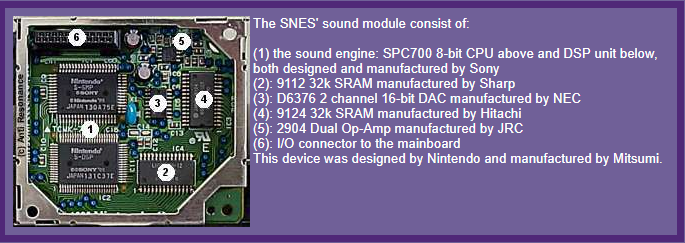- Part 1: How the sound is made
- Part 2: How the CPU does what
- Part 3: Writing the first ROM file
Some basic investigation whether a project is even possible to realize is obviously mandatory if it's something you've never done before. Most of the times I get stuck in this phase though, so this time I wanted to limit myself to essential things and not research too much (which turned out to be a good idea).
In this first part I want to talk about how sounds on the SNES are created, but don't worry, this one is going to be a short one. :)

Most of the work is done by the synthesizer chip - the SPC-700. This is actually already a co-processor for the main CPU on the SNES. It runs at roughly 1MHz, has access to 64KB of memory and has 4 8-bit I/O ports to transfer data to/from the SNES. The sound is composed of 8 channels of compressed sample synthesis in 8bit resolution. This means, the SPC-700 laods a short sample of audio into one of the 8 channels and then it reads from its own program memory what it's going to do with this sample. At the most basic level, it's going to repeat this one sample in an infinite loop, so if you store a sine wave of 1kHz in a channel, you're going to hear a sine wave sound at 1kHz. So, to "play" this sound musically, the SPC is also able to "tune" and "pitch shift" this sample. Together with an envelope shaper with paramters such as attack and release, it's already possible to mimic simple instrument sounds like on old 80s keyboards.
If you want to know more about wavetable synthesis, I can highly reccomend this short video about the basics: (it's attached at the bottom)
So basically, the SPC-700 needs samples and instructions to generate music. Turns out, there's already a small scene of people out there who build little devices to play such programs which are extracted from SNES ROMs. It's awesome! Check it out right here: http://snesmusic.org/files/spc700.html
But the APU (audio processing unit) of the SNES not only consists of the SPC-700. There's also a little DSP (digital signal processing) chip involved. When I said earlier that the SPC-700 is doing the pitch shifting, I was actually lieing (for simplicity reasons), because the pitch shifting is actually done by this DSP. It also has some neat features like echo effects and a white noise generator which will come in handy much later if we want to produce some rhythmic sounds. The DSP is accessed through the SPC-700, which makes the whole thing a little bit more complicated. But since both chips are fairly straight forward (I hope), everything will be fine... ;) Well, the SPC-700 has two registers which are directly wired to the DSP. So one register holds adresses for the DSP and one holds instructions.
Accessing both the SPC-700 and the DSP, again, is done through the main CPU. So next post will cover one of the greatest CPUs of all time: The 65816! If you've never heard of it before, I can tell you it's not much more than a 6502, which was the chip in legendary computers such as the Apple II, the Commodore 64 and the original Nintendo Entertainment System! <3
In the last part of "Is it even possible?" we're even going to write a little ROM file that generates sound and works on an emulator, so stay tuned!! This was the first time that I wrote my own ROM file for a vintage gaming console and I can tell you it's quite fascinating! :)
Oh and in case you want to check out some more in depth information on how sound on the SNES works, check out these technical documents: https://wiki.superfamicom.org/spc700-reference
Cheers,
Mike
 Foxchild
Foxchild
Discussions
Become a Hackaday.io Member
Create an account to leave a comment. Already have an account? Log In.